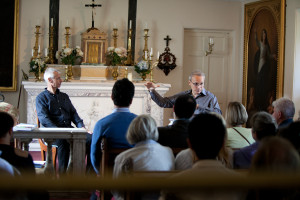
The 4Th Bækur, Landamæri og Hjól Festival var haldinn á lengsta stöðugt byggður Skotlands bústað, Traquair House á River Tweed í Scottish Borders. Skipulagðar af Beyond Borders Skotlandi er einstakt hátíð bókmenntum og hugsun sem koma saman leiðandi rithöfundar, stjórnmálamenn, hermenn, lawyers and artists to discuss topics relevant to international relations Scotland’s role in the world. Two talks “Understanding the Islamic World” and “Iraq Ten Years On: Hvaða lærdóm fyrir Sýrlandi og U.N.?"Bera erfðaskrá að breidd umræðu. SNSI coordinator, Robert Wild tóku þátt í tveimur greinum; göngutúr rétt "Ef tré gætu talað – hvað myndu þeir segja?", og tala um "Neuroscience af forn og Sacred Natural Sites".

The group on the trail with Ian Edwards, yfirmaður atburðum í Royal Botanic Garden Edinborg, ræða menningarlega félag trjám meðan Catherine Maxwell sem fjölskyldan hefur verið í búsetu fyrir 300 árum enda sögu trjánum. (Photos courtesy Beyond Borders)
The sunnudegi ganga var "A Talking Vísindi Project"Í samstarfi við Royal Botanic Garden Edinborg. Það kanna sögulega landslag Traquair og uppgötvaði sögur af ótrúlega trjám hennar (www.traquair.co.uk). Ian Edwards, yfirmaður atburðum í Royal Botanic Garden Edinborg, leiddi tala um líf-landfræðilegum sögu og menningar samtök trjám búsins meðal Yew, Lime, Silver Fir and Hazel. Catherine Maxwell Stuart, eigandi og sem fjölskyldan hefur verið í búsetu fyrir 300 árum enda sögu trjánum.
Hópurinn lauk með umræðum innan íhugunar stað búin af forn yews gætu hafa lifað af þeim tíma sem nú hreinsaðar ETTRICK Forest þar sem Traquair House - veiðihúsi af Scottish konunga þar í kring 1107 – was originally been situated. Robert posed that if trees could talk they may have a few questions of us like: Hvað gerðirðu við ETTRICK Forest? Hvað í ósköpunum hefur þú gert til að helmingur skóga á jörðinni? Ert þú ímyndað þér að líta eftir okkur tré? Really we look after you!
Following the walk the talk took place inside the packed Chapel. Entitled “The Neuroscience af forn og Sacred Natural Sites: TheHY forn stöðum kalla svo öflug halda yfir menningu okkar og ætti að vernda á tímum átaka ", the talk explored Sacred Natural Sites and made links to the emerging understanding of Neuroscience.
Robert kicked off saying that Sacred Natural Sites can be described as places where the human mind meets Nature. He observed that the Traquair chapel (sem er tiltölulega ný aðlagað fyrir þennan tilgang 1829) hafði nokkrar vísbendingar um eðli en það er líklegast að öll okkar helgu rými upphaflega unnin úr náttúrunni.
Robert fór að lýsa heilagt náttúrusvæða var og hvers vegna þeir hafa fengið áhuga á alþjóðlegu verndargildi hreyfingu. Nature conservation practitioners have a very pragmatic interest in sacred natural sites as they protect a wide range of rare species. This is particularly important as we have now entered the 7Th mikill útrýmingu atburður, with hundreds of species becoming extinct daily. Beyond this, þó, helga náttúruvætti embed in einnig djúpt sett af archetypes af mannlegum samskiptum sem við gætum lært af í að setja meiri sjálfbærri leið fyrir mannkynið.
Ein slík hugmynd er að 'Griðastaður' that seems to be a direct import from ancient European sacred groves into the early Christian church. Sanctuary arose in the sacred groves of Europe where, no hunting was allowed and if a hunted animal found refuge in a sacred grove the hunt had to stop. Human fugitives could also find sanctuary in the sacred grove. Many of these provisions still hold in the sacred groves of Africa and Asia. At some point this sanctuary principle transferred into the church.

Before getting into the neuroscience of the sacred, Robert Wild (vinstri) explored sacred sites as potential areas for limiting conflict. (Photos courtesy Beyond Borders)
Loksins, og áður en í taugavísindum við heilagt, Rob focused on sacred sites as potential areas for limiting conflict. Rob presented an example recently shared by colleagues at the Aigine Cultural Research Centre um 2010 Kirgistanska átök þar sem hundruð manna voru drepnir og þúsundir á flótta í átök milli kirgistanska og Uzbeks í suðurhluta landsins. Margir af landflótta íbúum finna athvarf í heilaga staður til að vera griðastaður í tíma átaka:
"Kamchieva Mopasha þjóðarbrota skáldsögur Úsbeska og 'shaiyks"Eða verndari síðunnar ríkja: “Þegar það er hörmung, fólk kemur að þessari Shrine og finna skjól ". According to her, á hæð á átökin í júní 2010, [margir] fór þangað bæði kirgistanska og Uzbeks, en þeir voru ekki að spyrja hver er hver, [en] saman sláturfórn Guði, máli fyrir endurreisn sátt og samlyndi. Margir pílagrímar hafði dvalið fyrir þá tvo eða þrjá daga [átök] á brún Mazar (helga síða). As [einn viðmælandi] Akbarov Salbar said, "Ekki einn nef eða einn munnurinn var meiddur". Annar viðmælandi sagði að hinn helgi staðir eru svæði án ofbeldis, and moreover places where steps are taken to overcome violence”.
At this point Robert then handed over to Tim Phillips. Tim is an international peace maker and co-founder of the Harvard University Project á Justice í Times of Umskipti og hefur tekið þátt í mörgum friðarviðræðum meðal Norður-Írlandi, Sri Lanka og í Mið-Austurlöndum.
Tim introduced the emerging discipline of neuroscience and discussed recent lessons that are being learnt in relation to conflict resolution. This includes that different types of thought pattern are processed in different parts of the brain. Different parts of the brain process different emotions and thoughts that are analogous the stages of evolution. Rational thought is now understood to be processed in a different part of the brain that deeply held and sacred values. These new understandings have profound implications for the way that we negotiate over issues. This is the case when seemingly rational solutions to deeply held or sacred values will not be easily considered by negotiating teams.
Sacred natural sites have been contested lands at the same time locations of peace and cooperation. They also embed critical models of human relationships with nature. At a time when our relationships with nature need significant healing; andlega, vísinda og félagslegur skilningur á mannlegri hegðun og aðgerða er nauðsynleg.






